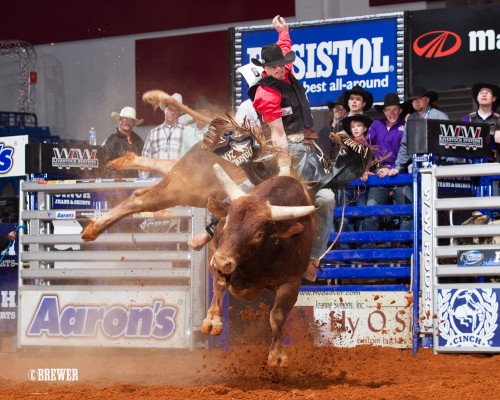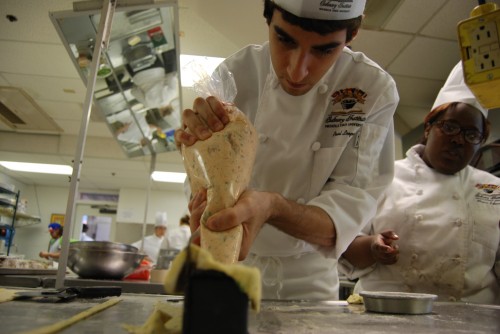Recipe: Turkey Pâté en croûte
November 1, 2012
Editor’s Picks for November
November 1, 2012As the students preparing dishes oozing Thanksgiving’s flavors begin to finish a four-hour lab, their instructor and one classmate are hashing out what went wrong with one of the products.
Chef Monica Larousse urges the student to stop berating herself over a soggy crust, telling her not to take sole responsibility for the shared project – a turkey pâté enfolded in hardened, pie-like dough.
“You have to relinquish control,” Larousse says, trying to soothe Felicia Pearce, who simply responds: “I can’t. I’m a perfectionist.”
Pearce, a junior from Morgan City who has long aspired to open a 50s-themed diner, is disappointed with excess moisture in the dough she and her peers prepared.
She did not attend to this dish start to finish because the students were partaking in a communication lesson that required two station changes, emphasizing the transition from one recipe into another. But Pearce believes she knows where the issue arose.
“(The recipe) could be adjusted: It says to boil the sweet potatoes, but I think if we had baked them, you wouldn’t have had to put them in water, so you wouldn’t have the moisture,” she says. “I think without the moisture, it would have come out just fine.”
The boiled sweet potatoes were ground into a pie-like dough that coarsens when heated. A mixture of turkey meat, spices and herbs – the pâté – was spread across salmon slices and inserted into the dough, which was baked and then placed into a cooler.
The turkey pâté en croûte recipe (next page) is based on the old-fashioned style of Garde manger, also the name of the course these students are taking at the John Folse Culinary Institute.
“They have to figure out where in their palate that this food fits,” Larousse says.
Garde–manger is a French word literally meaning one who keeps food. In the English language, it identifies a cook whose specialty is preparing food served cold, such as meat, gelatin and salads.
Practicing the trade is an effort in nuance, calculation and careful monitoring that borders on tedium at points (particularly for students who shut the oven door, look at a clock and wonder how they’ll make it to their next class). The website www.gardemanger.com says it is “considered by many to be the most demanding station/job in any kitchen” because of the attention to detail and various skills required. Larousse agrees with that description.
“Garde manger is so unforgiving, especially with pâtés in the fact that when you put it all together, you can’t go back and season it later,” she says of one of the many challenges. “It’s done.”
Although the culinary style is demanding, students say the turkey pâté dish wasn’t too challenging. It’s a dish well suited for homebound cooks with moderate experience, they say.
“The majority of the work was deboning the turkey,” says Karl Cantrelle Jr., a 35-year-old senior in his third year at Nicholls’ culinary institute. “Other than that, it was a pretty easy recipe.”
An important element of learning Garde manger, and at John Folse in general, is how to be creative with classic flavors, Larousse says, and that’s one reason why turkey pâté was chosen as lab work.
“In the fall, I really like to make the turkey (pâté) with the sweet potato dough because it tastes like Thanksgiving, and it’s just one more way for them to see classic flavors put together a different way.”
Larousse has instructed at Nicholls for three years after obtaining an undergraduate degree from the university and a master’s from the University of New Orleans.
The Pride, La., native says the Garde manger class focuses on modern techniques of the trade while also offering a glimpse at where it began.
“A lot of these old techniques are still very common down here, in the South, especially Cajun creole,” Larousse says, using tasso and blood and andouille sausage as examples.
The students are judged on an assortment of categories, including presentation, taste and the consistency of the forcemeat mixture, which needs to satisfy several guidelines. The students tend to refer to the texture as “Spam-ish.”
“We don’t like to refer to it like that because it reduces its (perceptive) quality immediately,” Larousse says. “But it is a little finer than a fresh sausage that you might find. It is closer to a Spam texture; it should be very sliceable when it’s cold and all hold together.”
Although the students couldn’t immediately sample the dish – because it has to be served cold – Pearce says she’ll consider preparing it as an entrée at home, based on the composition. She says amateur chefs should try it, as well.
“The difficulty level isn’t high,” Pearce says. “It’s a lot of attention to detail, watching your temperatures, watching your time. Other than that, it’s very doable.”
Nicholls State University culinary student Paul Lupo squeezes forcemeat mixture into dough while preparing a pâté en croûte.
Student Megan Edwards listens to instructor Chef Monica Larousse while Lupo looks on.
April Kreamer looks on while Larousse gives instruction on giving dough consistency.
John Folse Culinary Institute department head John Kozar’s baking class prepares dinner rolls.







